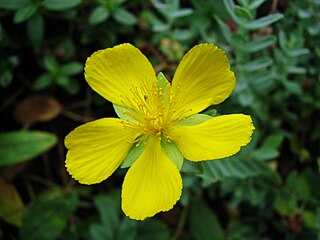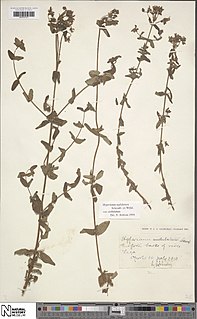
Hypericum is a genus of flowering plants in the family Hypericaceae. The genus has a nearly worldwide distribution, missing only from tropical lowlands, deserts and polar regions. Many Hypericum species are regarded as invasive species and noxious weeds. All members of the genus may be referred to as St. John's wort, and some are known as goatweed. The white or pink flowered marsh St. John's worts of North American and eastern Asia are now separated into the genus Triadenum.

Hypericum mutilum is a species of St. John's wort known by the common name dwarf St. John's wort. It is native to parts of North America and is present in other parts as an introduced species. It is an annual or perennial herb taking a multibranched erect form up to about 60 centimeters tall. The oval green leaves are one or two centimeters long and are covered in tiny glands. The inflorescence is a compound cyme of tiny flowers. H. mutilum subsp. mutilum and subsp. boreale have a diploid number of 16, and H. mutilum subsp. boreale can have a diploid number of 18.

Hypericum olympicum, commonly known as the Mount Olympus St. John's wort, is a species of flowering plant in the family Hypericaceae found in the Balkans and Turkey and introduced to western Europe. It has been widely cultivated for centuries because of its large, showy flowers, which are far larger than those of most other species in Hypericum.
Hypericum acmosepalum is a dwarf shrub in Hypericumsect. Ascyreia that is native to China and known as jian e jin si tao locally.
Hypericum cuisinii is a perennial herb in the genus Hypericum, in the section Adenosepalum. The herb has pale yellow flowers and occurs in Greece and Turkey.

Hypericum undulatum, the wavy St Johns Wort, is a herbaceous perennial flowering plant native to western Europe and northern Africa. The specific name undulatum is Latin, meaning "wavy" or "undulated", referring, just as the common name, to the wavy leaf margins of the herb. The plant has a diploid number of 16 or 32.
Hypericum edisonianum, known as Arcadian St. John's wort, Edison's St. John's wort, and Edison ascyrum, is a species of flowering plant in the St. John's wort family, Hypericaceae. It is endemic to Florida.

Hypericum japonicum, also known as matted St. John's-wort or Japanese St. John's wort, is an annual herbaceous flowering plant in the St. John's wort family Hypericaceae, section Trigynobrathys.

Hypericum suffruticosum, known as pineland St. John's-wort, is a species of flowering plant in the St. John's wort family, Hypericaceae. It is native to the Southeastern United States.
Hypericum sampsonii is a species of flowering plant in the St. John's wort family, Hypericaceae. It occurs in China, Taiwan, Japan, Myanmar, and Vietnam. It is one of two species of Hypericum in the section Hypericum sect. Sampsonia.

Hypericum tetrapetalum, the fourpetal St. Johnswort, is a species of flowering plant in the St. John's wort family, Hypericaceae. It is found in the Southeastern United States and Cuba. It was first described by Jean-Baptiste Lamarck in 1797.

Hypericum lancasteri, known as Lancaster's St. John's wort or as zhan e jin si tao in Chinese, is a species of flowering plant in the St. John's wort family Hypericaceae.
Hypericum assamicum is a species of flowering plant in the St. John's wort family, Hypericaceae. It is endemic to India. Hypericum assamicum is one of two species of Hypericum in the section Hypericum sect. Sampsonia.
Hypericum sect. Sampsonia is a small section of plants in the genus Hypericum. It comprises only two species, both endemic to eastern Asia: Hypericum sampsonii and Hypericum assamicum.

Hypericum patulum, known as goldencup St. John's wort or yellow mosqueta, is a species of flowering plant in Hypericumsect. Ascyreia.

Hypericum formosissimum is a species of flowering plant in the family Hypericaceae, section Adenosepalum, in the Hypericum huber-morathii group.

Hypericum huber-morathii is a flowering plant in the family Hypericaceae, section Adenosepalum, and the type species of the Hypericum huber-morathii group.

Hypericum aucheri, also known as Koramanotu in Turkish, is a herbaceous perennial flowering plant in the St. John's wort family Hypericaceae.

Hypericum coris, the heath-leaved St. John's wort, also called yellow coris, is a species of flowering plant in the family Hypericaceae, and is the type species of sect. Coridium. It is a low shrub, and it is found in Switzerland and northwestern Italy. The species has been a popular garden plant since the 18th century, valued for its long flowering period and for how well it adapts to cultivation.
















